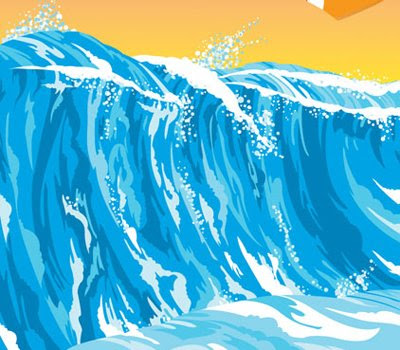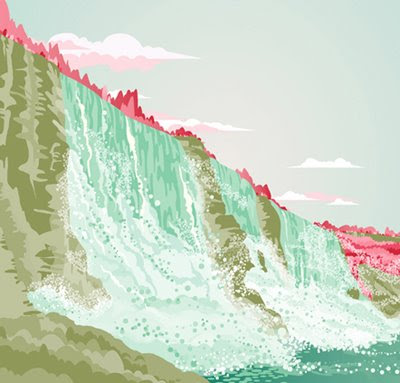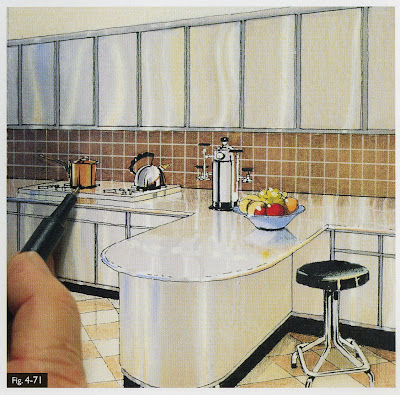Firstly, hello to all the students and teachers over there! Ben and Fi here, from
Ben the Illustrator and
Wish You Were Here! Thanks for giving us the opportunity to guest post on your blog, it's always a pleasure to work with universities, discuss techniques and hopefully we can share a few nuggets of wisdom with you!
So, we're going to focus on water here. We're really inspired by water ourselves, we live near the beach and are surrounded by lakes and streams, we observe it, we enjoy it and we re-create it a lot in our illustration and design work. Water can add a lot of atmosphere to an illustration, it can be soothing and calming, epic and exciting, clean and refreshing, it is also crucial to it's surroundings, whether it's a small woodland stream, an epic coastline or a feature in a modern piece of architecture. Since water does come in different forms, many of which you might have to depict in your architectural drawings, it is a good idea to think about different ways of depicting it, being able to simply show if it's still or flowing, deep or shallow, and how it sits in it's surroundings.
Bens going to go it alone for a while here now to indulge himself in some good drawing talk!
First up, and the key thing that helped me figure out the best way to draw water... look at water. Spend some time looking at photos or videos of water, or better still see it for yourself, rivers, fountains, oceans, if you can, just stand and look at it. Crucially, look at the shapes it makes, and look at the shapes created within the water, so look at the actual shape of a wave (ignore the predictable way a child might draw a wave) or look at how water actually flows in a river, especially the way it flows over rocks. If you can break an area of water into separate shapes, or even patterns, then you're heading in the right direction. Water is usually made up of the same shapes over and over again, so feel free to re-use your shapes, whether you're drawing in pencil or doing a vector illustration on your computers.
The illustration below I did a few years ago now, but it was one of the first times I was satisfied that what I was illustrating actually looked like water, the key to it was the shapes of the waves. I had spent some time obsessively studying wave forms for real, and then breaking them into basic shapes, which I then adapted to my own style of drawing and the kind of shapes I use in my illustration work.

Following on from the shapes within a body of water, there is also the shape of the body of water itself, especially important for still water, which may not have much texture to it. If the water is natural, then the shapes it takes will also be natural, so you'll rarely find a straight line, but more so natural curves or rough edges. A drawn body of water doesn't always have to have a frilly edge like we think it should, it can have a perfectly smooth edge, and people will still know what it is. In the illustration below, you can see all the streams of water flowing towards you from the waterfall, and you know exactly what they are, yet all they are is smooth-edged, snake-like shapes.

Once you're getting somewhere with the basic shapes, start thinking about water as three different layers... firstly there is the depthy layer under the water, do you need to show anything under there? Then there is the surface itself, which can be either transparent, looking through to the deep, or reflective, mirroring what is around the water, the final layer is whatever is on top of the surface, foam, spray, bubbles etc.
For the deep layer, you might want to show fish, plants or anything structural, but understand that it wouldn't be perfectly clear, to achieve this it could be blurred or of limited colours, or your surface layer could be a semi-transparent tint of a colour, see the first illustration below.
The surface can either be textured if the water is flowing or flat if it's still. If it's still, it will often reflect at least a little, whether you're drawing this on paper or creating it on your computer, the simplest way to achieve this is to copy what you have above the surface, upside-down on top of the surface, often slightly squashed down, see the second illustration below.


For the top layer, any bubbles, foam, spray etc, you are again best off looking at what basic shapes there are, with water I find that the predominant shape is a circle, simple as that, but what gives the right effect is the amount of circles and how intensely they are gathered together. So in the first illustration below I have added small bunches of white and blue circles to depict the clean little sprays coming off this wave, in the second illustration there are millions of circles all gathered together (of different transparency levels) to make a huge cloud of spray at the foot of the waterfall. These two illustrations are also good examples of the shapes I see in the texture of water, the different tones of blue in the wave in the first illustration, there's only three tones of blue there, but it seems to show a real depth and weight to the water in the wave.


Finally, after shapes, textures and all the 'parts' that make up a body of water... colour. We all know that water is usually known as blue, but if you get the shapes right, you can make it any colour, it can really set a mood, it can be green, it can be any blue from cyan to turquoise, it can be pink, red or orange under the right natural lighting. Some of the illustrations I have shows here use the same theory on colour... use three or four different tones of the same blue, from a light through to a dark, deep water is dark, light shining off water is light, sheets of water will have a mixture of tones in them, just break these tones up into shapes or patterns and spread them around!
I think that's plenty enough water talk from over here, hope we haven't bored you or filled up your blog with our waffling! Good luck with your drawings, feel free to email if you've any questions! We'd love to see what you're all up to. Before we go, we have to admit something... we are incredibly jealous that you've just visited Fallingwater! We are huge fans of modern architecture ourselves and a visit to Fallingwater would be part of an absolute dream holiday for us both!
Keep creating
Ben & Fi!







 Once you're getting somewhere with the basic shapes, start thinking about water as three different layers... firstly there is the depthy layer under the water, do you need to show anything under there? Then there is the surface itself, which can be either transparent, looking through to the deep, or reflective, mirroring what is around the water, the final layer is whatever is on top of the surface, foam, spray, bubbles etc.
Once you're getting somewhere with the basic shapes, start thinking about water as three different layers... firstly there is the depthy layer under the water, do you need to show anything under there? Then there is the surface itself, which can be either transparent, looking through to the deep, or reflective, mirroring what is around the water, the final layer is whatever is on top of the surface, foam, spray, bubbles etc.
 For the top layer, any bubbles, foam, spray etc, you are again best off looking at what basic shapes there are, with water I find that the predominant shape is a circle, simple as that, but what gives the right effect is the amount of circles and how intensely they are gathered together. So in the first illustration below I have added small bunches of white and blue circles to depict the clean little sprays coming off this wave, in the second illustration there are millions of circles all gathered together (of different transparency levels) to make a huge cloud of spray at the foot of the waterfall. These two illustrations are also good examples of the shapes I see in the texture of water, the different tones of blue in the wave in the first illustration, there's only three tones of blue there, but it seems to show a real depth and weight to the water in the wave.
For the top layer, any bubbles, foam, spray etc, you are again best off looking at what basic shapes there are, with water I find that the predominant shape is a circle, simple as that, but what gives the right effect is the amount of circles and how intensely they are gathered together. So in the first illustration below I have added small bunches of white and blue circles to depict the clean little sprays coming off this wave, in the second illustration there are millions of circles all gathered together (of different transparency levels) to make a huge cloud of spray at the foot of the waterfall. These two illustrations are also good examples of the shapes I see in the texture of water, the different tones of blue in the wave in the first illustration, there's only three tones of blue there, but it seems to show a real depth and weight to the water in the wave.
 Finally, after shapes, textures and all the 'parts' that make up a body of water... colour. We all know that water is usually known as blue, but if you get the shapes right, you can make it any colour, it can really set a mood, it can be green, it can be any blue from cyan to turquoise, it can be pink, red or orange under the right natural lighting. Some of the illustrations I have shows here use the same theory on colour... use three or four different tones of the same blue, from a light through to a dark, deep water is dark, light shining off water is light, sheets of water will have a mixture of tones in them, just break these tones up into shapes or patterns and spread them around!
Finally, after shapes, textures and all the 'parts' that make up a body of water... colour. We all know that water is usually known as blue, but if you get the shapes right, you can make it any colour, it can really set a mood, it can be green, it can be any blue from cyan to turquoise, it can be pink, red or orange under the right natural lighting. Some of the illustrations I have shows here use the same theory on colour... use three or four different tones of the same blue, from a light through to a dark, deep water is dark, light shining off water is light, sheets of water will have a mixture of tones in them, just break these tones up into shapes or patterns and spread them around!






 these are showing how to do your renderings in steps and use a gradient to create reflective surfaces
these are showing how to do your renderings in steps and use a gradient to create reflective surfaces
 this is showing the importance of colored pencils
this is showing the importance of colored pencils